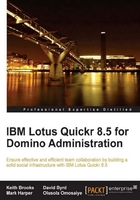
The Lotus Quickr connectors represent key capability common across both Lotus Quickr architecture platforms. These connectors are deployed locally on Windows-based workstations to allow direct integration into the productivity applications, which a user already comfortable with. That allows a user to continue to work in Lotus Notes or Microsoft Office and directly manage the content on the Lotus Quickr servers.
The architecture of the desktop connectors allow them to integrate with various backend server environments including Enterprise Content Management (ECM) systems. IBM has made available, the Lotus Quickr integration code for IBM FileNet and Content Manager, to allow them to appear as a traditional Lotus Quickr server to these desktop connectors. From an end user standpoint, they don't have to be directly aware the type of system they are using to store their data. They can focus on producing content and interacting with other team members.
An example of interacting with the Quickr Connector from the Microsoft Windows Explorer is shown in the following screenshot:

This integration allows an end user to treat Lotus Quickr like just another folder. The exception is that it includes rich content services such as check-in/check-out and enhanced meta data entry.
Additional information on the Lotus Quickr connectors is available in Chapter 10, IBM Lotus Quickr Connectors.